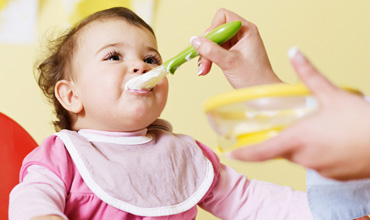Assessment of Weaning Practices of Mothers of Under-Five Children Attending Infant Welfare Clinic, Wesley Guild Hospital, Ilesa, Osun State

Abstract:
This
study was conducted to assess the weaning practices of mothers of under-five children
attending Infant Welfare Clinic, Wesley Guild Hospital, Ilesa, Osun State. The aim
was to assess the knowledge, weaning practices, nutritional status of the under-fives
and factors affecting weaning practices. Findings will help improve mothers’ weaning
practices and also provide empirical evidences for nurses for health education.
A descriptive survey design was adopted and samples selected though convenient sampling.
135 questionnaires were administered and filled by the participants.
Findings
showed that majority (92.6%) had good knowledge about weaning practices. A 55.6%
initiated weaning at 4-6months of age. About two-third (65.2%) wean their babies
with solid foods and larger percentage used milk substitutes for their child. Maternal
smoking, lack of knowledge, lack of support, low maternal education, and low socio-economic
status were factors identified influencing weaning practices of mothers. Moreover,
the study determined the nutritional status of the under-five children. The findings
also showed that 65.9% of the respondents’ babies had normal weight, while 28.9%
had underweight. Significant association was found between maternal education, occupation
and the age of initiation of weaning (P = .001)
In
conclusion, despite adequate knowledge of weaning and exclusive breastfeeding among
mothers, only about half started weaning at 4-6month, more than a quarter of the
children were under-nourished. This shows a gap between knowledge and practice.
Therefore, it is recommended that nurses at all levels should educate mothers on
exclusive breastfeeding and good weaning practices to promote the health of under-five.
Keywords: Weaning
Practices of Under-five mothers
References:
[1]. Aggarwal A, Verma S, Faridi
MMA, and Dayachand, (2008). Complementary feeding reasons for inappropriateness
in timing, quantity and consistency. Indian
J Pediatr; 75: 49-53.
[2]. Amuna P., Zotor F, Chinyana Y.R (2010).
The role of traditional cereals / legumes / fruit– based multi mix in weaning in
developing countries. J Food Sci Nutri; 30: 116-122.
[3]. Bolling, K., Grant, C., Hamlyn, B., Thornton,
A. (2007). Infant feeding survey 2005. London: Information Centre [Online] Available
at: http://www.ic.nhs.uk/statistics-and-data-collections/health-and-lifestyles-related-surveys/infant-feeding-survey/infant-feeding-survey 2005.
[4]. Chatterjee S, & Saha SA, (2008). Study
on Knowledge and Practice of Mothers Regarding Infant Feeding and Nutritional Status
of Under – Five Children Attending Immunisation Clinic of a Medical College. The Internet Journal of Nutrition and Wellness; 5 (1).
[5]. Domellof M, Lonnerdal B, Abram S.A, &
Hernell O (2002). Iron absorption in breast – fed infants: effect of age, iron status,
iron supplements, and complementary foods. Am
JClin Nutr.; 76: 198-204.
[6]. FAO: State of Food Insecurity in the World,
2008: Food Security Statistics [http://www.fao.org/es/ess/faostat/foodsecurity/index_en.htm],
Retrieved on 30 March, 2010.
[7]. Imonikebe B. U. (2009). Weaning Practices
and Nutritional Status of Infants in Isoko North and South Local Government Areas
in Delta State, Nigeria. African Research Review; Vol. 3 (4), Pp. 191-207
[8]. Imtiaz M, & Izhar TS (2004). Feeding
practices of infants in Lahore. Pak pediar J; 21:115-20
[9]. Olagunju F. I. & Babatunde R. O. (2011).
Prevalence and Determinants of Malnutrition among Under-five Children of Farming
Households in Kwara State, Nigeria. Journal
of Agricultural Science Vol. 3, No.
3.
[10]. Pongou R, Ezzati M, & Salomon JA
(2006). Household and Community Socioeconomic and Environmental Determinants of
Child Nutritional Status in Cameroon. BMC,
Public Heath, 6.98:19.
[11]. Stewart-Glenn J. (2009). Knowledge, perception
and attitude of managers, co-workers and employed breastfeeding mothers. AAOHN J. 2009;56(10):423-9.
[12]. UNICEF, (2007). Malnutrition in South
Asia, A Regional Profile, Nov. 2007. UNICEF- Regional Office for South Asia, 73
Lodi Estate, New Delhi 110 003, India.
[13]. UNICEF (2011). Our promise to the world's
children” The state of the world's children, Early Childhood, 2011. UNICEF: 3, United
Nations Plaza, New York 10017, USA.
[14]. UNICEF (2008). The state of the world's
children, Child Survival, 2008. UNICEF: 3, United Nations Plaza, New York 10017,
USA
[15]. Wijndaele K, Lakshman R, Landsbaugh JR,
Ong KK, & Ogilvie D (2009). Determinants of early weaning and use of unmodified
cow's milk in infants: a systematic review. J
Am Diet Assoc. 2009 Dec; 109 (12): 2017-28.
[16]. World Health Organization (2009). Global
strategy for infant and young child feeding. Geneva,WHO, 2009.
[17]. World Health Organization & United Nations Children's Fund (2005). Global strategy for infant and young child feeding.
[18]. Wright C. M., Cameron K., & Tsiaka M. (2011). Is baby-led weaning feasible? When do babies first reach out for and eat finger foods? Matern Child Nutr.; 7:27–33.

